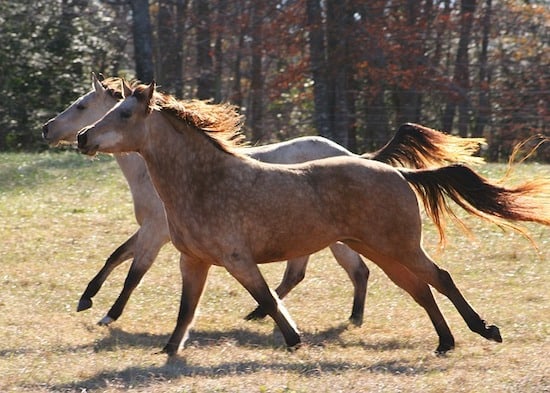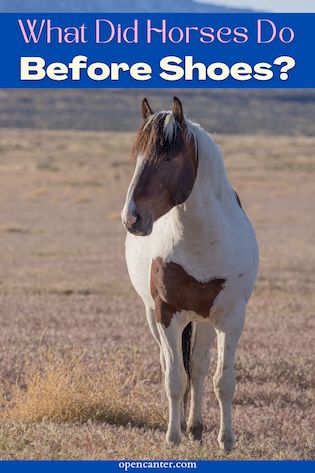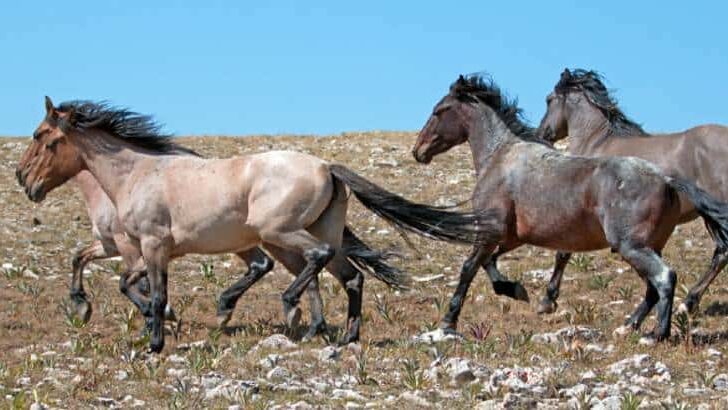Affiliate Disclaimer
As an Amazon Associate I earn from qualifying purchases. It helps me keep the website going. Thank you for your support.
There are different theories about how horses survived before domestication and the invention of the metal horseshoe. Originally thought of as a way to protect hooves, some people now believe that horseshoes do more harm than good. So, what did horses do before shoes?
Having healthy hooves to run away from predators was integral to the survival of horses. Before domestication and before the time when horses had shoes, they lived a nomadic lifestyle. They ran from place to place finding grass to eat and the running wore down their hooves into the perfect shape for their existence.
Evolution of the Horse Hoof From 5 Toes to One Shod Hoof
The evolution of horses from having actually 5-toes to 3-toes, to one hoof is a matter of climate change combined with the principles of mechanics and anatomy.

How Horses Got One Hoof
The evolution of horses from having actually 5-toes to 3-toes, to one hoof is a matter of climate change combined with the principles of mechanics and anatomy.
Nearly 60 million years ago the original tiny five-toed horse existed and transitioned in 30 million years to the three-toed horse which eventually migrated to Asia, then spread to Europe and Africa.
The more familiar equine, the modern Equus, first appeared four million years ago.
This modern equine had a unique and efficient leg shape, called a “spring-leg”. Its way of moving in the trot allowed it to cover long distances to forage for grass.
Climate change led to grasslands being further apart and longer distances needed to be covered.
The Equus had a better ability to roam and a built-in efficiency of locomotion. This allowed it to rely on grass that was further apart which helped it survive while others went extinct.
When The Horse Was Domesticated
Even though horses appeared around 30,000 BCE in Paleolithic cave art, they were not domesticated and most likely hunted for meat.
How and when horses became domesticated is highly debatable.
The clearest evidence is horses were used as transport for chariot burials around 2000 BCE.
There is currently a growing amount of evidence that horses were domesticated in the Eurasian Steppes as early as 3500 BCE.
Ways Hooves Were Protected Before Shoes
Once horses were domesticated, they became like live equipment. People began putting more consistent wear and tear on their horses and the number one break point was their hooves.
People with horses had to find a way to extend the health of the hoof and protect their tools.
Horsemen throughout Asia equipped their horses with booties made from woven plants. There were instances where horses’ hooves were wrapped in rawhide, leather, or other materials for both therapeutic purposes and protection from wear.
It’s been documented that Romans used a boot-like shoe called a “hipposandal” and the Chinese used rattan and leather shoes.
Why The Shoes Originated
The domestication of horses and the change from their natural way of nomadic living are the main reasons their hooves changed.
Softer hooves, when subjected to added stresses like the weight of a rider or a cart or wagon, can become excessively worn. These types of use can sometimes create lameness and/or injury and render a horse unusable.
Putting on a metal horseshoe helps to prevent the breakdown of the soles and edges over rough terrain. The location on the hoof where a farrier nails on the shoe does not hurt the horse.

What Did Horses Do Before Shoes And Is It Best For Them
Wild horses traversed terrain that would ruin the feet of a domesticated horse. Once a horse had a hoof injury or body injury stemming from a hoof failing, they became the number one target of predators.
Herds have been documented, from the foals to the aged horses, moving effortlessly and efficiently across unbelievably harsh terrain.
Horses that live in the wild have to navigate rough pastures. The climate and type of ground they have to cover will depend upon the country they live in. Many wild horses live in arid climates with little rainfall. The ground is rocky and inhospitable. In large countries, wild horses will invariably walk up to 20 miles a day in search of water or food.
A young horse’s hooves will adapt well to the rough desert-like ground. The shape and strength of the hoof in early years will adapt to cope with the demands of day-to-day life. By adulthood, the structure of the horse’s hooves is well suited to the rigors of daily life.
Wild horses’ chances for survival were much better if they could keep up with their herd.
Some Drawbacks To Shoes
These ideas, from Dr. Lisa Ross-Williams’ book, Down-to-Earth Natural Horse Care, are fanning the flames of the current argument that barefoot is better.
- Decreased shock absorption: Horses’ feet expand naturally without shoes every time they put their weight on them. Shoes decrease this ability to absorb this shock by 70-80%. The shock has adverse effects on the legs, joints, tendons, and even the lungs!
- Metal vibration damages tissue: Horseshoes vibrate at a very high frequency which can damage living tissue. Breakdowns can occur from this vibration and increase the chances of diseases such as arthritis, ringbone, and sidebone.
- Decreased traction: Metal shoes inhibit the natural traction action of the barefoot. An unshod hoof has skid-saver action, suction cup-ability, and an all-terrain “feel” for the horse through the hoof.
- Hoof contraction: The horseshoe shape contracts the natural spreading action of hoof growth. Shod hooves grow in a squeezed position. Imagine what it would feel like to wear shoes that are way too tight all the time.
- Prevents the development of a young horse’s feet: The coffin bone, also known as the pedal bone is the last bone in a horse’s leg. Its shape is similar to the shape of the hoof, and the capsule of the hoof wraps around it. The hoof wall protects the coffin bone, never the less it can still fracture. Under age 5 the coffin bone isn’t fully developed and shoeing it too early prevents its normal growth.
There Is No “one best way” – The University of Queensland Study
In a study about the way wild horses’ feet change depending on the terrain they cover, veterinarians studied wild horse populations in four different types of habitats. Dr. Brian Hampson, DVM ultimately concluded there is no one natural foot type in horses and, contrary to popular belief, feral horses are not exempt from developing lameness.
In his conclusion, Hampson cautioned, there was currently no evidence that the hooves of wild horses should be thought of as a recommended model for equine foot care (source).

Final Thoughts
Therefore, what did horses do before shoes, or really, what the contemporary shoes vs. barefoot controversy truly boils down to is that horseshoes are merely another option.
It is probable that when they were first introduced, horseshoes seemed like the single, miraculous solution to keeping horses’ hooves in the best shape to keep them working. However, we now know that each horse’s hooves are subject to many factors in the decision to keep them barefoot or shod.




